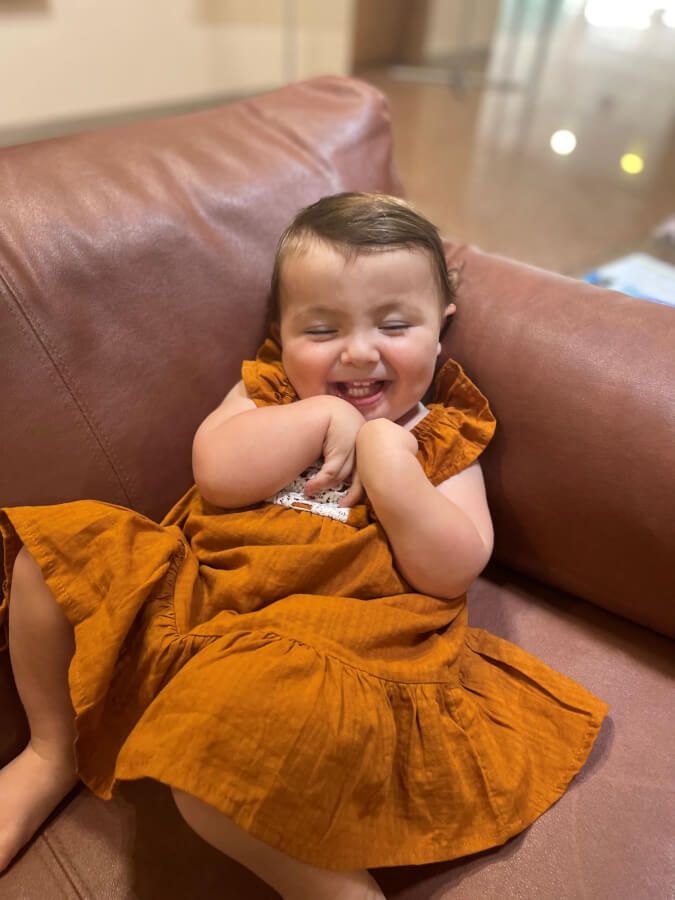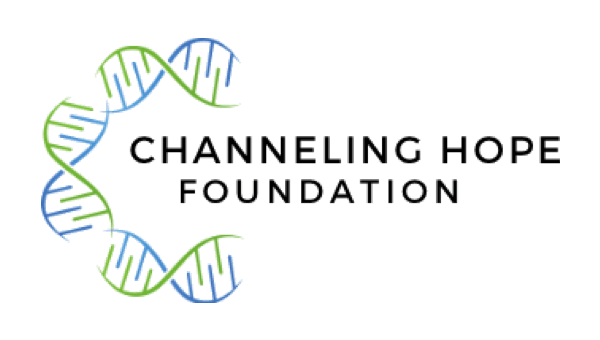This story was first published in the June 2025 issue of Bexar County Medical Society’s San Antonio Medicine magazine.
For Jeremy Tanner, MD, behavioral neurologist and assistant professor of neurology at The University of Texas Health Science Center at San Antonio (UT Health San Antonio) and Glenn Biggs Institute for Alzheimer’s and Neurodegenerative Diseases, and Shayanne Martin, MPH, senior project manager at the Charles E. Cheever, Jr. Center for Medical Humanities and Ethics at UT Health San Antonio, what began as a personal journey transformed into a global mission of advocacy to understand and research an ultra-rare neurogenetic disease. When their daughter, Cora, was diagnosed with a rare neurogenetic disease, it shifted their career paths and priorities in unexpected ways. They realized the path toward real progress involved a coordinated effort to understand and find treatments for these conditions that, until recently, have remained largely unexplored.
Shared passion for public health
Jeremy and Shayanne’s journey together began at Johns Hopkins University, where both were studying public health. Jeremy, a Houston native, had been drawn to medicine after witnessing the devastating effects of Alzheimer’s disease on his grandmother. His career trajectory led him to specialize in neurology, with a focus on Alzheimer’s and dementia, recognizing early on the growing impact of these diseases.
Shayanne spent her early career working in global health, particularly in infectious diseases. Her work involved securing grants and collaborating with governments and universities to improve health care delivery in low- and middle-socioeconomic status countries. When the couple moved to Texas, Martin’s focus shifted to community-based public health, where she leads initiatives such as training community health workers.
An unexpected diagnosis
In 2022, the couple was living in San Francisco where Jeremy was finishing his neurology residency and behavioral neurology fellowship. The couple planned to move to Africa for a year for a global neurology fellowship before accepting a faculty position in the United States.
Those plans changed dramatically when the couple learned they were expecting their first child. Initially, the only concern was a clubfoot seen on ultrasound — which the physician said was treatable. Recommended prenatal genetic testing came back normal. After Cora’s birth in March 2022, however, additional features prompted the couple to push for whole exome sequencing, a cutting-edge genetic test that can evaluate a range of genes at the same time and see all protein-coding portions of those genes. Whole genome sequencing has only become widely available in the past five to 10 years and was often only used if a genetic condition was suspected.
At six weeks old, Cora was diagnosed with an ultra-rare and severe neurodevelopmental disease called CLIFAHDD — Congenital Contracture of the Limbs and Face, Hypotonia and Developmental Delay. At the time, with fewer than 30 documented cases worldwide, there was little information available. Many children with this condition did not survive early childhood, and those who did required lifelong care.

“As first-time parents, we were devastated. We didn’t know what to expect going forward, or what to expect at all,” Jeremy said.
A shift in focus
Faced with uncertainty, Jeremy and Shayanne immersed themselves in research, reaching out to scientists and medical experts around the world. They discovered that CLIFAHDD is a result of a random genetic mutation affecting the sodium leakage channel protein (NALCN), which plays a crucial role in neural function. While NALCN research was advancing in Europe, there was no active work being conducted in the United States.
“Where Alzheimer’s disease was 20 years ago is where the neurogenetic disease space is now. But this also means there is a huge opportunity for growth and development,” Jeremy said.
The family moved to San Antonio, where UT Health San Antonio staff and faculty supported them both professionally and personally. Jeremy said prior to moving, they were able to meet with physicians at the UT Health San Antonio complex care clinic, including Cora’s current specialist Glen Mendellin, MD, to review her care. They also met with neurogenetics care staff at the Texas Children’s Hospital. Jeremy said along with his regular duties, Sudha Seshadri, MD, director of the Biggs Institute, encourages his research into NALCN-related conditions. Shayanne said the Cheever Center for Medical Humanities and Ethics provides flexibility in her schedule to take Cora to medical appointments.
“It was a great fit for our family, they really went above and beyond anywhere else,” Jeremy said.
The birth of Channeling Hope Foundation
Jeremy and Shayanne realized that the best way to advocate for more research and treatment development for CLIFAHDD and other ultra-rare conditions would be to create a focused nonprofit organization.
“The only way to develop a treatment is to have a strong patient advocacy organization and nonprofit bring together the resources, raise funds, bring communities together and bring the scientists together,” Jeremy said.
In 2023, they co-founded the Channeling Hope Foundation along with other parents of children with ultra-rare diseases. The organization’s mission is to unite families, scientists and clinicians to advance research and treatments for CLIFAHDD and other NALCN-related conditions. With no prior experience in nonprofit management, the couple quickly learned how to navigate the new challenges of fundraising and a new direction for their prior experiences in advocacy, scientific collaboration and capacity building.
At the first international NALCN conference in Spain, the couple connected with researchers who had already developed disease models. These collaborations created the groundwork for potential treatments, including drug repurposing to identify existing Food and Drug Administration-approved medications that may help patients with CLIFAHDD.
A growing movement
The Channeling Hope Foundation has rapidly expanded its network, engaging families and scientists worldwide. With support from the Chan Zuckerberg Initiative Rare As One Network, the foundation recently secured $800,000 in funding over the next five years. While this funding is not for research, it provides critical support for organizational growth and capacity building.
On the research front, Jeremy is working with UT Health San Antonio scientists at the Center for Innovative Drug Discovery and international collaborators to develop the first high-throughput screening and drug discovery program for NALCN-related conditions. He is also working with Baylor College of Medicine scientists to develop the first induced pluripotent stem cell line as an open resource for the scientific community to study these conditions and to begin to develop genetic therapies.
Looking to the future
The next major milestone will be the second international NALCN conference, set to take place in October 2025 in San Antonio. This gathering will bring together families, researchers and clinicians to share the latest findings and launch a natural history study — an essential step for future clinical trials.
“In order to test a treatment, you have to see the natural course of the disease and how treatment changes that course,” Jeremy said.
Despite the demands of leading a nonprofit while raising a child with special needs, Martin and Jeremy remain deeply committed to their professions. Shayanne balances her role as executive director of the Channeling Hope Foundation with her professional responsibilities while also pursuing a doctorate in public health. She credits the support of her colleagues at the Charles E. Cheever, Jr. Center for Medical Humanities and Ethics for enabling her to continue her work.

“For me, it’s the support system,” she said. “Being given that flexibility and freedom to pursue this work has enabled me to stay in the workforce.”
As advancements in genetic testing and treatments develop, the landscape for rare disease research is evolving rapidly. The more widespread availability of whole-exome sequencing has made it possible to discover and correctly diagnose rare genetic conditions sooner.
“This space is growing fast,” Jeremy says. “More diseases are being diagnosed, and with better genetic testing, we’re identifying conditions that were previously misclassified. The capabilities of UT Health San Antonio provide a great opportunity for us to become leaders in the space of ultra-rare diseases.”
The couple welcomed their second child in January. At the UT Health San Antonio obstetrics and gynecology center, the genetic counseling team conducted whole-exome sequencing prenatally and confirmed that the child did not carry the CLIFAHDD mutation.
“Here, the genetic counselor listened to us. She said, ‘I’ll advocate for you.’ At the lab she explained that there was a reason [for the sequencing test]. This is a new space in science and medicine. The sooner you know, the sooner you can prepare and consider treatment options,” Shayanne said.
With unwavering determination, Jeremy and Shayanne are proof that when families and scientists work together, there is hope for even the rarest diseases. Their journey shows what is possible when science, collaboration and determination come together.


